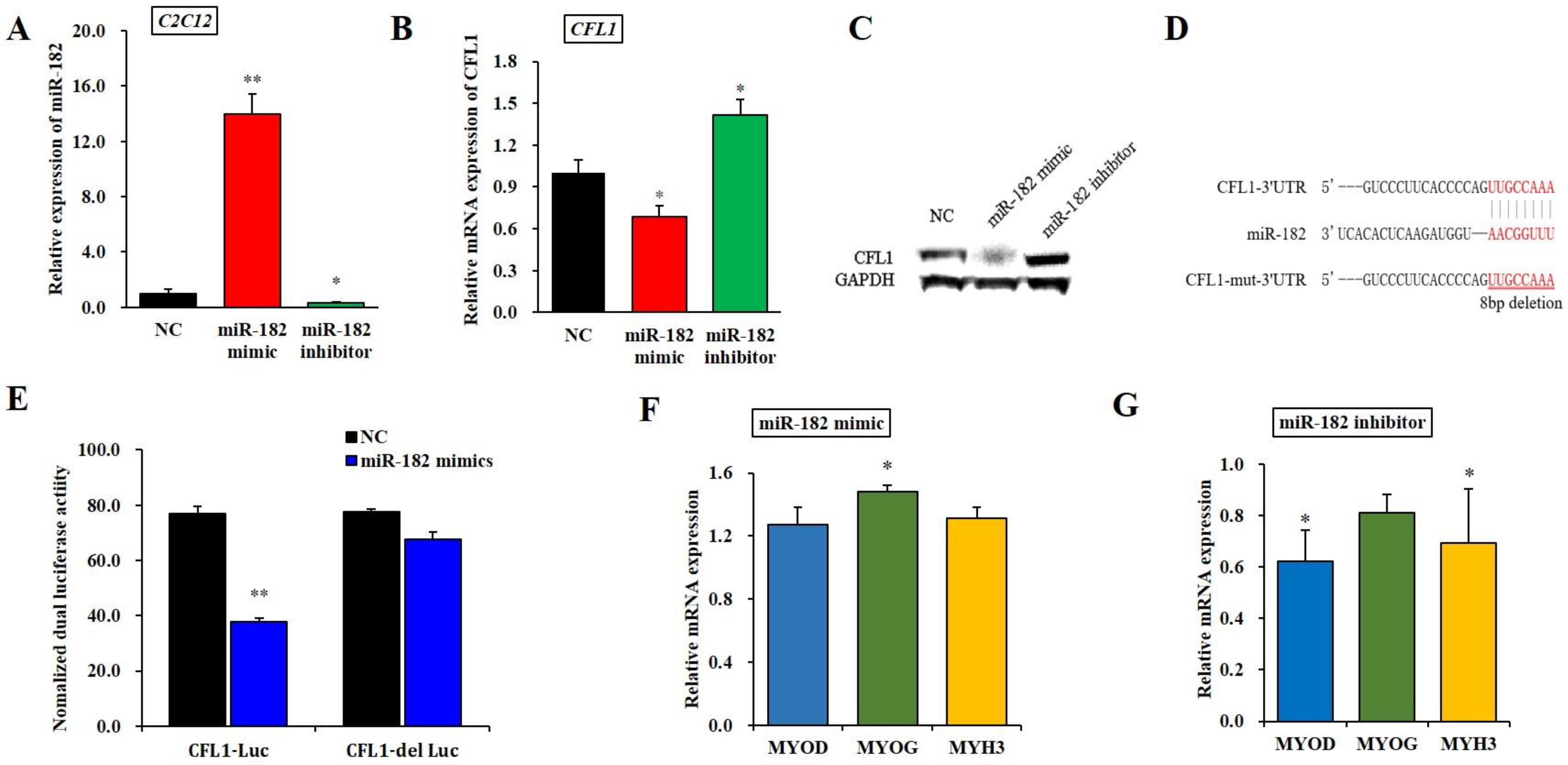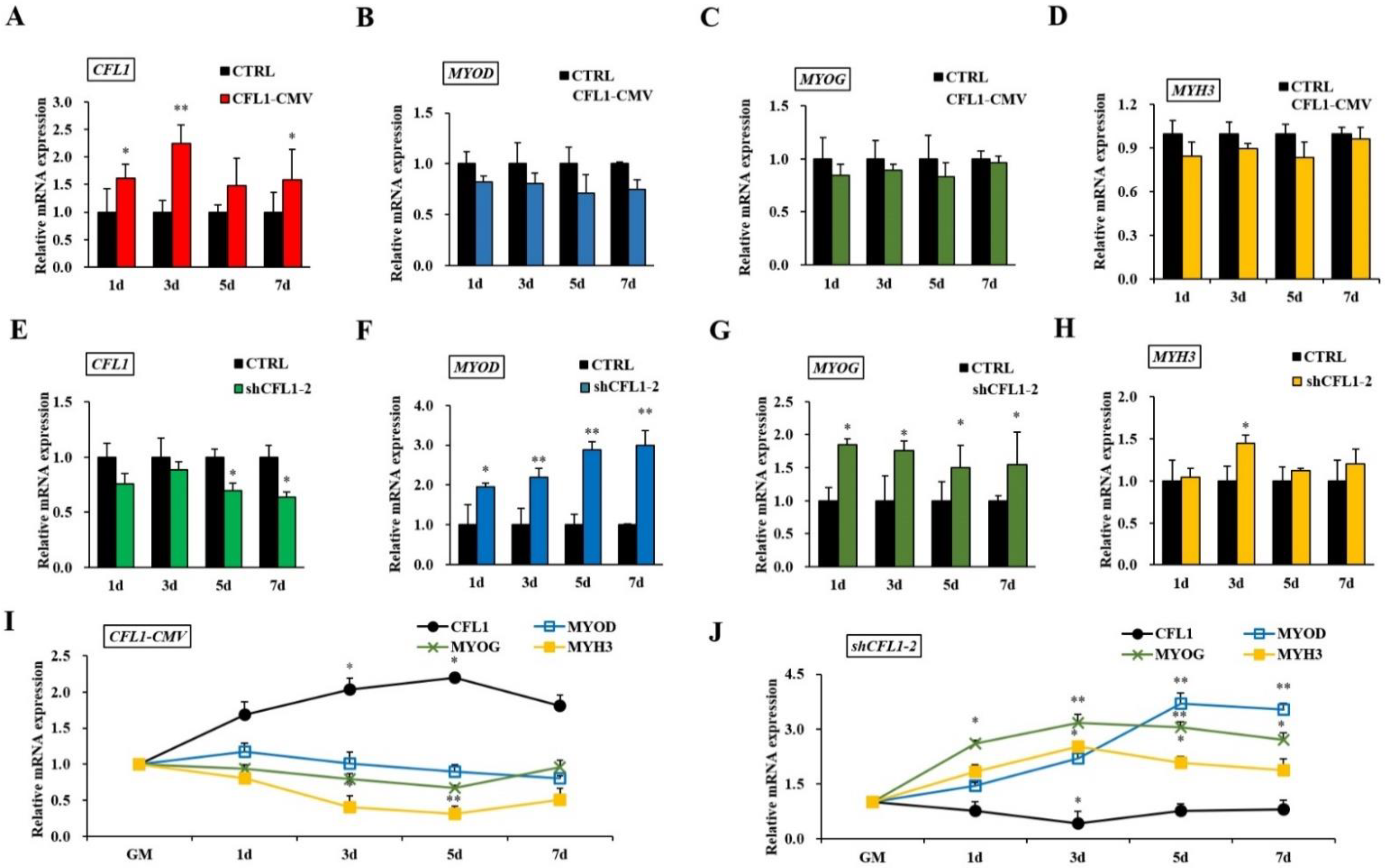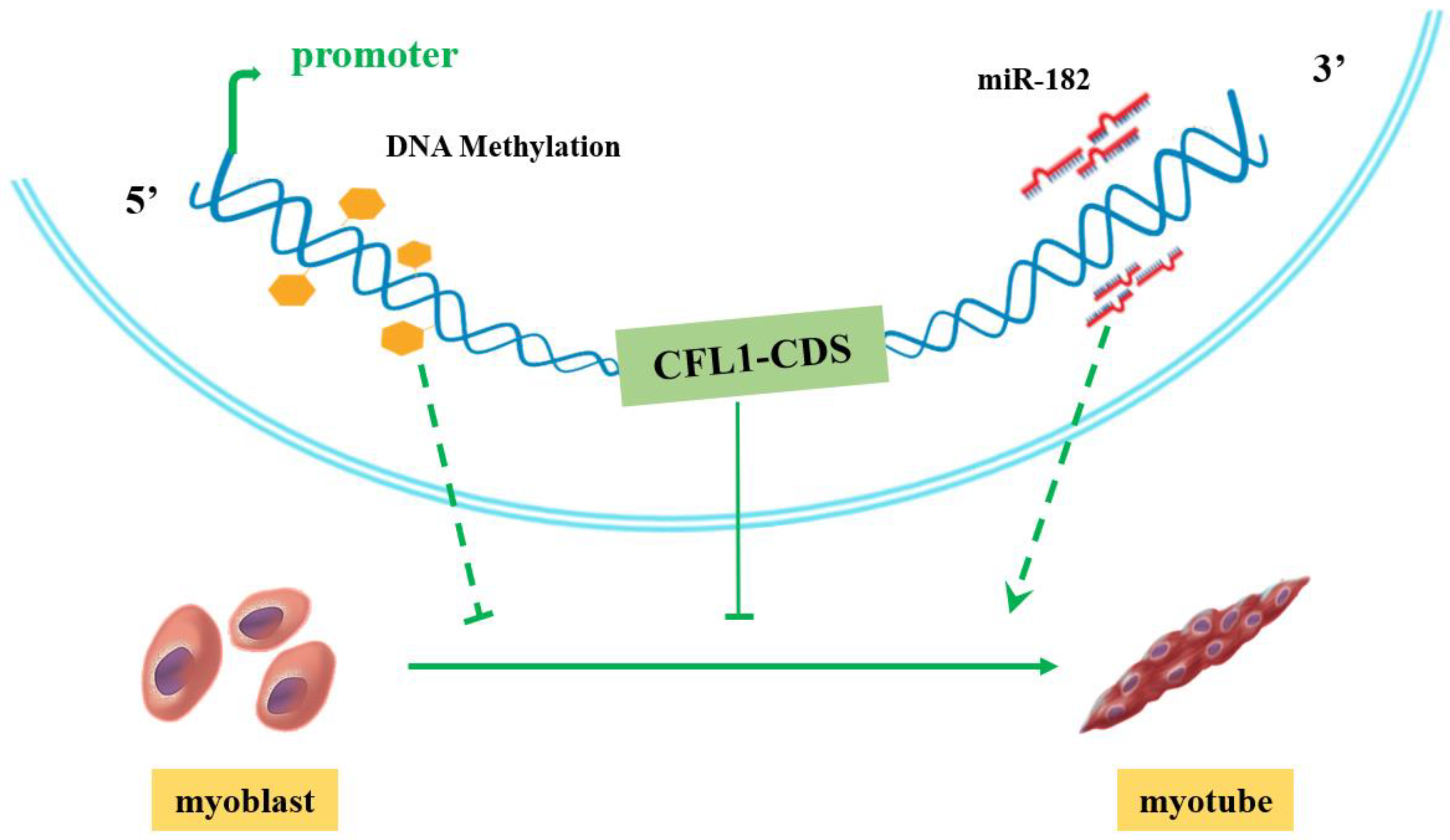Epigenetic Regulation Mechanisms of the Cofilin-1 Gene in the Development and Differentiation of Bovine Primary Myoblasts
Abstract
:1. Introduction
2. Materials and Methods
2.1. Ethics Approval and Consent to Participate
2.2. Tissue Preparation and Cell Culture
2.3. Vector Construction
2.4. Cell Treatment
2.5. Dual Luciferase Reporter Assay
2.6. Quantitative Real-Time PCR (qRT-PCR) and Western Blot
2.7. Bisulfite Sequencing Polymerase Chain Reaction (BSP) and COBRA
2.8. Statistical Analysis
3. Results
3.1. Spatiotemporal Expression Patterns of the CFL1 Gene
3.2. Study on DNA Methylation Level of CFL1 Gene Promoter
3.3. Target Regulation of the CFL1 Gene by microRNA
3.4. Effects of the CFL1 Gene on the Differentiation of Myoblasts
4. Discussion
5. Conclusions
Supplementary Materials
Author Contributions
Funding
Institutional Review Board Statement
Informed Consent Statement
Data Availability Statement
Acknowledgments
Conflicts of Interest
References
- Goldberg, A.D.; Allis, C.; Bernstein, E.J.C. Epigenetics: A Landscape Takes Shape. Cell 2007, 128, 635–638. [Google Scholar] [CrossRef] [PubMed] [Green Version]
- Pas, M.T.; Keuning, E.; Hulsegge, B.; Hoving-Bolink, A.H.; Evans, G.; Mulder, H.A. Longissimus muscle transcriptome profiles related to carcass and meat quality traits in fresh meat Pietrain carcasses. J. Anim. Sci. 2010, 88, 4044–4055. [Google Scholar] [CrossRef] [PubMed]
- Hotulainen, P.; Paunola, E.; Vartiainen, M.K.; Lappalainen, P. Actin-depolymerizing Factor and Cofilin-1 Play Overlapping Roles in Promoting Rapid F-Actin Depolymerization in Mammalian Nonmuscle Cells. Mol. Biol. Cell 2005, 16, 649. [Google Scholar] [CrossRef] [PubMed]
- Ono, S.; Minami, N.; Abe, H.; Obinata, T. Characterization of a novel cofilin isoform that is predominantly expressed in mammalian skeletal muscle. J. Biol. Chem. 1994, 269, 15280–15286. [Google Scholar] [CrossRef]
- Rust, M.B. Novel functions for ADF/cofilin in excitatory synapses—Lessons from gene-targeted mice. Commun. Integr. Biol. 2015, 8, e1114194. [Google Scholar] [CrossRef] [PubMed] [Green Version]
- Kuramitsu, Y.; Wang, Y.; Okada, F.; Baron, B.; Tokuda, K.; Kitagawa, T.; Akada, J.; Nakamura, K. Malignant progressive tumor cell clone exhibits significant up-regulation of cofilin-2 and 27-kDa modified form of cofilin-1 compared to regressive clone. Anticancer Res. 2013, 33, 3661. [Google Scholar]
- Moon, A.L.; Janmey, P.A.; Louie, K.A.; Drubin, D.G. Cofilin is an essential component of the yeast cortical cytoskeleton. J. Cell Biol. 1993, 120, 421–435. [Google Scholar] [CrossRef]
- Kazuko, I.; Kenji, M.; Seiji, M.; Hiroshi, K.; Eisuke, N.; Ichiro, Y. Isolation of a yeast essential gene, COF1, that encodes a homologue of mammalian cofilin, a low-Mr actin-binding and depolymerizing protein. Gene 1993, 124, 115–120. [Google Scholar] [CrossRef]
- Mohri, K.; Takano-Ohmuro, H.; Nakashima, H.; Hayakawa, K.; Endo, T.; Hanaoka, K.; Obinata, T. Expression of cofilin isoforms during development of mouse striated muscles. J. Muscle Res. Cell Motil. 2000, 21, 49–57. [Google Scholar] [CrossRef]
- Ikeda, S.; Cunningham, L.A.; Boggess, D.; Hawes, N.; Hobson, C.D.; Sundberg, J.P.; Naggert, J.K.; Smith, R.S.; Nishina, P.M. Aberrant actin cytoskeleton leads to accelerated proliferation of corneal epithelial cells in mice deficient for destrin (actin depolymerizing factor). Hum. Mol. Genet. 2003, 12, 1029–1037. [Google Scholar] [CrossRef]
- Gurniak, C.B.; Perlas, E.; Witke, W. The actin depolymerizing factor n-cofilin is essential for neural tube morphogenesis and neural crest cell migration. Dev. Biol. 2005, 278, 231–241. [Google Scholar] [CrossRef] [PubMed] [Green Version]
- Bellenchi, G.C.; Gurniak, C.B.; Perlas, E.; Middei, S.; Ammassariteule, M.; Witke, W. N-Cofilin Is Associated with Neuronal Migration Disorders and Cell Cycle Control in the Cerebral Cortex. Genes Dev. 2007, 21, 2347–2357. [Google Scholar] [CrossRef] [PubMed] [Green Version]
- Haibo, W.; Lide, T.; Feng, J.; Hao, G.; Xiaojun, D.; Tengyang, N.; Jun, F.; Yanbing, D.; Weiming, X.; Yayun, Q. Cofilin 1 induces the epithelial-mesenchymal transition of gastric cancer cells by promoting cytoskeletal rearrangement. Oncotarget 2017, 8, 39131. [Google Scholar]
- Miyake, M.; Takahashi, H.; Kitagawa, E.; Watanabe, H.; Sakurada, T.; Aso, H.; Yamaguchi, T.J.C.; Research, T. AMPK activation by AICAR inhibits myogenic differentiation and myostatin expression in cattle. Cell Tissue Res. 2012, 349, 615–623. [Google Scholar] [CrossRef]
- Luo, J.; Deng, Z.L.; Luo, X.; Tang, N.; Song, W.X.; Chen, J.; Sharff, K.A.; Luu, H.H.; Haydon, R.C.; Kinzler, K.W.; et al. A protocol for rapid generation of recombinant adenoviruses using the AdEasy system. Nat. Protoc. 2007, 2, 1236. [Google Scholar] [CrossRef] [Green Version]
- Li, L.C.; Dahiya, R. MethPrimer: Designing primers for methylation PCRs. Bioinformatics 2002, 18, 1427–1431. [Google Scholar] [CrossRef] [Green Version]
- Schmittgen, T.D.; Livak, K.J. Analyzing real-time PCR data by the comparative CT method. Nat. Protoc. 2008, 3, 1101–1108. [Google Scholar] [CrossRef]
- Kumaki, Y.; Oda, M.; Okano, M. QUMA: Quantification tool for methylation analysis. Nucleic Acids Res. 2008, 36, 170–175. [Google Scholar] [CrossRef]
- Bock, C.; Reither, S.; Mikeska, T.; Paulsen, M.; Walter, J.; Lengauer, T. BiQ Analyzer: Visualization and quality control for DNA methylation data from bisulfite sequencing. Bioinformatics 2005, 21, 4067–4068. [Google Scholar] [CrossRef]
- Sun, Y.; Liu, K.; Huang, Y.; Lan, X.; Chen, H. Differential expression of FOXO1 during development and myoblast differentiation of Qinchuan cattle and its association analysis with growth traits. Sci. China Life Sci. 2018, 61, 826–835. [Google Scholar] [CrossRef]
- Werle, S.D.; Schwab, J.D.; Tatura, M.; Kirchhoff, S.; Kestler, H.A. Unraveling the Molecular Tumor-Promoting Regulation of Cofilin-1 in Pancreatic Cancer. Cancers 2021, 13, 725. [Google Scholar] [CrossRef] [PubMed]
- Kakurina, G.; Cheremisina, O.V.; Sereda, E.E.; Kolegova, E.S.; Choinzonov, E. The Level of Cytoskeleton Remodeling Proteins in the Blood Serum and the Expression of Their mRNA in the Tumor Tissue in Metastasis of the Larynx and Hypopharynx Cancer. Mol. Biol. Rep. 2021, 48, 5135–5142. [Google Scholar] [CrossRef] [PubMed]
- Gillett, G.T.; Fox, M.F.; Rowe, P.; Casimir, C.M.; Povey, S. Mapping of human non-muscle type cofilin (CFL1) to chromosome 11q13 and muscle-type cofilin (CFL2) to chromosome 14. Ann. Hum. Genet. 2012, 60, 201–211. [Google Scholar] [CrossRef] [PubMed]
- Cedar, H.; Bergman, Y. Linking DNA methylation and histone modification: Patterns and paradigms. Nat. Rev. Genet. 2009, 10, 295–304. [Google Scholar] [CrossRef] [PubMed]
- Wang, D.; Wen, Y.; Zhang, Z.; Yang, S.; Liu, X.; Cai, C.; An, Q.; Lyu, S.; He, H.; Xie, J.; et al. DNA methylation status of SERPINA3 gene involved in mRNA expression in three cattle breeds. Anim. Biotechnol. 2021, 1–7. [Google Scholar] [CrossRef]
- Zhao, C.; Ji, G.; Carrillo, J.A.; Li, Y.; Tian, F.; Baldwin, R.L., VI; Zan, L.; Song, J. The Profiling of DNA Methylation and Its Regulation on Divergent Tenderness in Angus Beef Cattle. Front. Genet. 2020, 11, 939. [Google Scholar] [CrossRef]
- Huang, Y.Z.; Zhan, Z.Y.; Sun, Y.J.; Cao, X.K.; Li, M.X.; Wang, J.; Lan, X.Y.; Lei, C.Z.; Zhang, C.L.; Chen, H. Intragenic DNA methylation status down-regulates bovine IGF2 gene expression in different developmental stages. Gene 2014, 534, 356–361. [Google Scholar] [CrossRef]
- Shabalina, S.A.; Spiridonov, N.A. The mammalian transcriptome and the function of non-coding DNA sequences. Genome Biol. 2004, 5, 105. [Google Scholar] [CrossRef] [Green Version]
- Clifford, R.L.; Singer, C.A.; John, A.E. Therapeutics. Epigenetics and miRNA emerge as key regulators of smooth muscle cell phenotype and function. Pulm. Pharmacol. Ther. 2013, 26, 75–85. [Google Scholar] [CrossRef] [Green Version]
- Meyer, S.U.; Thirion, C.; Polesskaya, A.; Bauersachs, S.; Kaiser, S.; Krause, S.; Pfaffl, M.W. TNF-α and IGF1 modify the microRNA signature in skeletal muscle cell differentiation. Cell Commun. Signal. 2015, 13, 4. [Google Scholar] [CrossRef] [Green Version]
- Guttilla, I.K.; White, B.A. Coordinate Regulation of FOXO1 by miR-27a, miR-96, and miR-182 in Breast Cancer Cells. J. Biol. Chem. 2009, 284, 23204–23216. [Google Scholar] [CrossRef] [PubMed] [Green Version]
- Dcab, C.; Mxab, C.; Ygab, C.; Ling, X.; Tzab, C.; Yao, H.; Mzab, C.; Lxab, C.; Jie, L.; Jsab, C.J.B. LIPUS promotes FOXO1 accumulation by downregulating miR-182 to enhance osteogenic differentiation in hPDLCs. Biochimie 2019, 165, 219–228. [Google Scholar]
- Wallis, C.J.D.; Gordanpour, A.; Bendavid, J.S.; Sugar, L.; Nam, R.K.; Seth, A. MiR-182 Is Associated with Growth, Migration and Invasion in Prostate Cancer via Suppression of FOXO1. J. Cancer 2015, 6, 1295–1305. [Google Scholar] [CrossRef] [PubMed] [Green Version]
- Wang, F.; Wu, D.; Xu, Z.; Chen, J.; Zhang, J.; Li, X.; Chen, S.; He, F.; Xu, J.; Su, L.; et al. miR-182-5p affects human bladder cancer cell proliferation, migration and invasion through regulating Cofilin 1. Cancer Cell Int. 2019, 19, 42. [Google Scholar] [CrossRef] [PubMed] [Green Version]
- Casadei, L.; Vallorani, L.; Gioacchini, A.M.; Guescini, M.; Burattini, S.; D’Emilio, A.; Biagiotti, L.; Falcieri, E.; Stocchi, V. Proteomics-based investigation in C2C12 myoblast differentiation. Eur. J. Histochem. 2009, 53, e31. [Google Scholar] [CrossRef] [PubMed] [Green Version]
- Hitomi, K.; Murase, M.; Kawamura, T.; Maki, M.J.C. Constant expression of mouse calpastatin isoforms during differentiation in myoblast cell line, C2C12. Cytotechnology 2000, 33, 63. [Google Scholar] [CrossRef]
- Tian, X.; Lin, X.J.C.; Biology, I. Matricellular protein Cfl1 regulates cell differentiation. Commun. Integr. Biol. 2013, 6, e26444. [Google Scholar] [CrossRef]
- Hirayama, A.; Adachi, R.; Otani, S.; Kasahara, T.; Suzuki, K. Cofilin plays a critical role in IL-8-dependent chemotaxis of neutrophilic HL-60 cells through changes in phosphorylation. J. Leukoc. Biol. 2007, 81, 720–728. [Google Scholar] [CrossRef]






| Name | Primer (Contains Protective Bases and Restriction Sites) (5′–3′) |
|---|---|
| CFL1-CMV-F | CGGggtaccATGGCCTCCGGTGTGGCTGTCT |
| CFL1-CMV-R | CCCaagcttTCAcatcatcaccatcaccatCAAAGGCTTGCCCTCCAG |
| shCFL1-1F | gatccCCTCTATGATGCAACCTACTTCAAGAGAGTAGGTTGCATCATAGAGGtttttta |
| shCFL1-1R | agcttaaaaaaCCTCTATGATGCAACCTACTCTCTTGAAGTAGGTTGCATCATAGAGGg |
| shCFL1-2F | gatccGGATCAAGCATGAATTACAAGCAAATTCAAGAGATTTGCTTGTAATTCATGCTTGATCCtttttta |
| shCFL1-2R | agcttaaaaaaGGATCAAGCATGAATTACAAGCAAATCTCTTGAATTTGCTTGTAATTCATGCTTGATCCg |
| shRNA-NC-F | gatccTTCTCCGAACGTGTCACGTTTCAAGAGAACGTGACACGTTCGGAGAAtttttta |
| shRNA-NC-R | agcttaaaaaaTTCTCCGAACGTGTCACGTTCTCTTGAAACGTGACACGTTCGGAGAAg |
| Name | Primer (Wild Site Contains Protective Bases and Restriction Sites) (5′–3′) |
|---|---|
| CFL1-wild-F | CCGCTCGAGACTGCTACGAGGAGGTCAAG |
| CFL1-wild-R | ATAAGAATGCGGCCGCTCAACCCAAGAGGAATCAAG |
| CFL1-mut-F | TCCCTTCACCCCAGCAGCCCCCCCGACCC |
| CFL1-mut-R | TCGGGGGGGCTGCTGGGGTGAAGGGACTG |
| Name | Primer (Wild Site Contains Protective Bases and Restriction Sites) (5′–3′) |
|---|---|
| CFL1-F | GTGTGGCTGTCTCTGATG |
| CFL1-R | CGCTTCTTCACTTCCTCTG |
| bta-miR-182-RT | GTCGTATCCAGTGCAGGGTCCGAGGTATTCGCACTGGATACGACAGTGTGAG |
| bta-miR-182-F | ACACTCCAGCTGGGTTTGGCAATGGTAGAA |
| miR-R | GCAGGGTCCGAGGTATTC |
| U6-F | GCTTCGGCAGCACATATACTAAAAT |
| U6-R | CGCTTCACGAATTTGCGTGTCAT |
| GAPDH-F | AGATAGCCGTAACTTCTGTGC |
| GAPDH-R | ACGATGTCCACTTTGCCAG |
| Name | Primer (5′–3′) |
|---|---|
| CFL1-DMR-F | TGTTTTAATAAGGATATTTAGGGTATTT |
| CFL1-DMR-R | CTCAATAAAAAACTACAACTCAACC |
Publisher’s Note: MDPI stays neutral with regard to jurisdictional claims in published maps and institutional affiliations. |
© 2022 by the authors. Licensee MDPI, Basel, Switzerland. This article is an open access article distributed under the terms and conditions of the Creative Commons Attribution (CC BY) license (https://creativecommons.org/licenses/by/4.0/).
Share and Cite
Sun, Y.; Ma, Y.; Zhao, T.; Li, M.; Mao, Y.; Yang, Z. Epigenetic Regulation Mechanisms of the Cofilin-1 Gene in the Development and Differentiation of Bovine Primary Myoblasts. Genes 2022, 13, 723. https://doi.org/10.3390/genes13050723
Sun Y, Ma Y, Zhao T, Li M, Mao Y, Yang Z. Epigenetic Regulation Mechanisms of the Cofilin-1 Gene in the Development and Differentiation of Bovine Primary Myoblasts. Genes. 2022; 13(5):723. https://doi.org/10.3390/genes13050723
Chicago/Turabian StyleSun, Yujia, Yaoyao Ma, Tianqi Zhao, Mingxun Li, Yongjiang Mao, and Zhangping Yang. 2022. "Epigenetic Regulation Mechanisms of the Cofilin-1 Gene in the Development and Differentiation of Bovine Primary Myoblasts" Genes 13, no. 5: 723. https://doi.org/10.3390/genes13050723
APA StyleSun, Y., Ma, Y., Zhao, T., Li, M., Mao, Y., & Yang, Z. (2022). Epigenetic Regulation Mechanisms of the Cofilin-1 Gene in the Development and Differentiation of Bovine Primary Myoblasts. Genes, 13(5), 723. https://doi.org/10.3390/genes13050723







